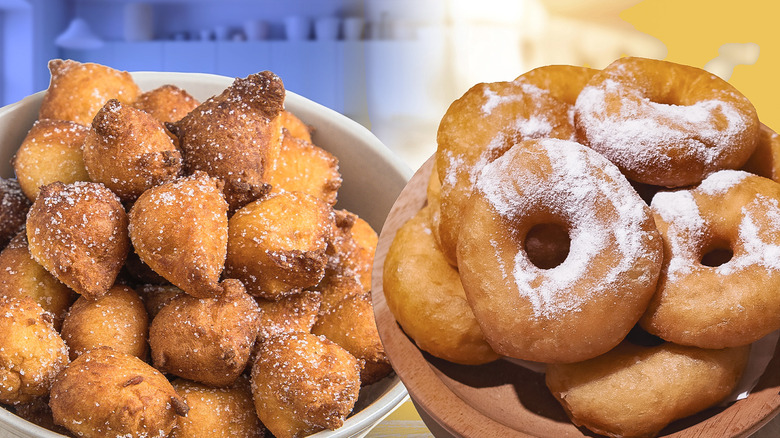Here's What Makes Fritters Different From Typical Donuts
Wading into the specifics of food definitions is always a fraught thing, even when the items in question are as relatively simple as donuts and fritters. The two doughy treats are not just both breakfast staples, they are usually sold together in the same shops. Ask someone what a donut is, and you may get some hemming and hawing (is a beignet a donut?), but generally, you know a donut when you see one. Once you get into fritters, though, things get less clear. After all, there are actually a lot more fritters than just the ones you get at donut shops. Are those fritters types of donuts, or are all donuts a type of fritter? Well, like any food definition, the answer is never cut and dry, but the clearest answer is that donuts are in fact a type of fritter ... usually.
What makes a fritter is pretty simple, which makes the term expansive. A fritter is anything made out of fried dough. So beignets are fritters, as are Italian zeppole, but so are savory vegetable fritters, hush puppies, and technically even tempura. The ones you get at donut shops are usually specifically fruit fritters, but that is only one small corner of the fritter world. And since yeasted donuts are made by frying, they are a type of fritter too. The things that make donuts a specific sub category is that they are sweet, ring-shaped, with or without a hole, and leavened. But of course, there are some exceptions.
Exceptions to the rule
The complicating factor here are cake donuts. They are both sweet and ring shaped — all good there — and they are leavened, usually with chemical leaveners rather than yeast. The issue is how they are cooked. Cake donuts are traditionally fried as well, but there are some that are baked instead. Since the unifying factor of fritters is that they are fried dough, baked cake donuts would technically not be fritters, even though fried cake donuts would be. Confusing? For sure. How much it matters depends on how pedantic you want to be. All this just goes to show how the original definitions of foods can evolve over time based on different contexts.
That's clear when you consider the many different types of donuts you'll find now. Long Johns are not ring shaped, but nobody would argue they aren't a donut. And bear claws are even farther away, not only being a unique shape, but also usually being made with puff pastry. Yet, you'll almost always see either of those two in a donut shop. The fritters you get at donut shops are distinguished from other donuts mostly by their shape and their filling, but you could say that about filled Long Johns too. So while most donuts are clearly a category of fritter, what makes a donut specifically is going to be more in the eye of the beholder than anything.

